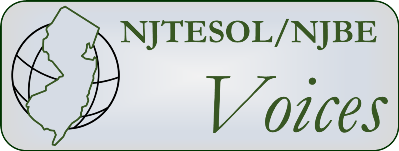NJ Teachers of English to Speakers of Other Languages/
NJ Bilingual Educators
ARTICLES
Adult Ed: Andrea S. Fonteñez- Equity for English Language Learners: Teaching and Assessing Online
Bilingual Elementary 1-8: Jack Meyers- What Does Remote Learning Look Like with Limited Technology?
Early Childhood: Jessica Perdomo-O’Hara- Advocate, Share, Reach Out!
ESL Elementary: Angela Pape- Targeting Vocabulary Instruction
Higher Education: Patricia George- Writing to Reinforce Critical Thinking Skills
Parent and Community Action: Gabriela Colon- Supporting Newly Arrived Families in their Quest for a Great Education
Special Education: Solange A. Lopes Murphy with Guest Contributor Sarah Westfall- Translanguaging in the Classroom
Supervisors: Laura Arredondo- Youth Participatory Action Research in New Brunswick
Teacher Education: Lisa Rose Johnson- NJTESOL/NJBE Advocacy for Teacher Education
Equity for English Language Learners: Teaching and Assessing Online
Andrea S. Fonteñez, Ed.D.
 Emergent Bilinguals are the fastest-growing student population, and teachers must find creative ways to ensure that equitable practices both in and out of the classroom are implemented, whether it is in person or remotely.
Emergent Bilinguals are the fastest-growing student population, and teachers must find creative ways to ensure that equitable practices both in and out of the classroom are implemented, whether it is in person or remotely.
According to the United States Census Bureau, “The Hispanic population of the United States is large and growing…The growth in the Hispanic population has been accompanied by a growth in the Hispanic student population. From 1996 to 2016, the number of Hispanic students enrolled in schools, colleges, and universities in the United States doubled from 8.8 million to 17.9 million. Hispanic students now make up 22.7 percent of all people enrolled in school. The increase in Hispanic enrollment is seen at all levels of education from nursery school to college.” With these changing school demographics, equitable teaching practices are needed to best address the needs of all English language learners. These equitable teaching practices also extend to remote online teaching and assessment.
The first step is to ensure that equitable teaching practices are in place via an effective online teaching platform. Such an online platform should allow teachers to have virtual academic conversations that promote students’ academic vocabulary development. Designing equitable online instruction also requires teachers to take into consideration students’ academic background, native language, and literacy proficiency levels.
Besides, online effective teaching practices should include differentiated assessments that provide educators with meaningful information that can be used to improve instruction and support students’ academic language development (NJDOE, The FABRIC Paradigm). Online individualized assessments should include tests, quizzes, projects, reports, and the like that address the different language domains of Listening, Reading, Writing, and Speaking. Also, assessments should be based on students’ English Language Proficiency levels and follow grading rubrics such as the Interpretive WIDA Rubric for Speaking and Writing, as well as teacher-created rubrics for reading and listening comprehension skills.
It is also important to mention that online instruction and assessment should incorporate flexibility on deadlines and/or opportunities to revise and resubmit after receiving feedback from the teacher. Every English language learner’s home situation is unique. Some students are faced with various challenges that range from taking care of younger siblings, working long hours, to limited Internet connectivity.
Besides, currently available technology allows for daily online small group instruction where students have the opportunity to interact remotely with one another and with the teacher, ask questions, and receive immediate feedback. Teachers can hold daily online meeting hours to answer questions and have students practice speaking and listening skills via a reliable cloud platform for video and audio conferencing, chat, and webinars.
Finally, thanks to technology, it is possible for English language learners to receive the necessary support to acquire language while meeting rigorous academic standards. Teachers can differentiate language development tasks and assessments based on students’ level of language proficiency and academic background. Indeed, technology creates varied and meaningful pathways for equitable online teaching and learning practices.
References
“FABRIC: A Learning Paradigm for ELLs” by New Jersey Department of Education (n.d.), retrieved on 3/15/2020 from https://www.nj.gov/education/bilingual/pd/fabric/fabric.pdf
“Placing English Language Learners in a Program of Instruction” retrieved on 3/10/2020 from https://www.colorincolorado.org/article/placing-english-language-learners-program-instruction
“Equity for English-Language Learners” retrieved on 3/15/2020 from https://www.edutopia.org/blog/equity-for-english-language-learners-rusul-alrubail
“School enrollment of the Hispanic Population: Two Decades of growth” by Kurt Bauman (2017), United Census Bureau, retrieved on 3/15/2020 from https://www.census.gov/newsroom/blogs/random-samplings/2017/08/school_enrollmentof.html#:~:text=The%20growth%20in%20the%20Hispanic,8.8%20million%20to%2017.9%20million
“Coronavirus Closures? Online Learning Tips for Teachers and Schools [interview with an American Teacher in China” by Kasey Bell (2020), retrieved on 3/15/2020 from https://shakeuplearning.com/blog/coronavirus-closures-online-learning-tips-for-teachers-and-schools-interview-with-an-american-teacher-in-china/
Andrea S. Fonteñez, Ed.D. is the Adult Education Special Interest Group (SIG) Representative and the Director of Bilingual/ESL Education at the New Brunswick Public Schools.
What Does Remote Learning Look Like With Limited Technology?
By Jack Meyers
 Since early March, 2020, we have been experiencing an unprecedented public health emergency. Schools and government offices are closed, and people are being warned to keep their social circles tight to slow the progression of COVID-19. So, what does that mean for teachers and for our students? How will learning continue? What will their skills and knowledge bases look like after widespread, long-term absences from schooling?
Since early March, 2020, we have been experiencing an unprecedented public health emergency. Schools and government offices are closed, and people are being warned to keep their social circles tight to slow the progression of COVID-19. So, what does that mean for teachers and for our students? How will learning continue? What will their skills and knowledge bases look like after widespread, long-term absences from schooling?
Perhaps most importantly for our population, that is ELLs (English Language Learners/Emergent Bilinguals), who are often socioeconomically disadvantaged and vulnerable based on their immigration statuses, how can remote learning work without internet or technology? In other words, what do we do when our students cannot reliably access at home all of the tools we provide them for learning during the school day? It seems at the moment that we have more questions than answers, but in this piece, I hope to shed light on some useful tips and tricks for braving the storm.
While I recognize that hindsight is 20/20, I suggest you consider the following ideas when getting to know your students in the coming school years, and even consider improvements you can make for the rest of this school year.
Tips for Supporting Families & Students in Remote Learning With
(Very Little) Technology
1. Ask yourself, what technology do I, as an instructor, have access to and feel comfortable using at home?
2. (With your district’s/administrator’s permission) Communicate families on a regular basis via phone call using an identity-obscuring service like Google Voice.
3. Once in contact with families, survey their access and needs.
a. Can they watch videos on phones or tablets at home?
b. Do they know where to access free public Wi-Fi?
c. Do they have access to a public library where they can access online learning materials? Etc.
d. Is there anything I (we) can do to support them?
4. Use a digital communication service that does not require usage of internet or mobile data.
a. Remind – I like using Remind because it shows up on families’ mobile phones like text messages that they can respond directly to. And I can access this via computer or phone, but don’t need to use my own phone number!
b. Class Dojo – Class Dojo be very useful for contacting ELLs’ families because it translates communication into other languages with relatively high accuracy.
5. Create or even do a quick search for YouTube video read-alouds to be used on any device or Screencasts (click the link for a tutorial) for asynchronous learning.
a. The important take-away here is that all of these can be accessed from public wi-fi points or using very little mobile data
b. Also, promote flexibility by not requiring students to be online at specific times (that is, encourage asynchronous learning)!
6. Finally, reassure families that you care about them and their students and their well-being, regardless of academic productivity. Connection and compassion are during trying times key!
While this pandemic will be over eventually, emergency school closures are a reality. I imagine we will look back with heavy hearts knowing we could have been more prepared. Once we get back to our students and our classrooms, we should begin to restructure our instruction so that it is possible for students to continue learning in the event of long-term absences. While remote learning is challenging, sometimes it is for the best, and now I hope we all walk away from this time with some newfound clarity and purpose.
Sincerely,
Jack Meyers
Jack Meyers is the Bilingual Elementary SIG Representative.
Advocate, Share, Reach Out!
By Jessica Perdomo-O’Hara
 We all have been busy and overwhelmed these days with a massive amount of information about health, safety, and resources coming to us from social media, family, friends, and basically, everyone who crosses our paths. In the midst of all this, while I was trying to keep my sanity, we were told that we were closing the school for two weeks, and the team (and everyone, really) had two days to make plans for two weeks of remote learning. For those of us, who work with the youngest pupils, to put together two weeks worth of Literacy, Math, and Physical activity learning activities and materials to send home.
We all have been busy and overwhelmed these days with a massive amount of information about health, safety, and resources coming to us from social media, family, friends, and basically, everyone who crosses our paths. In the midst of all this, while I was trying to keep my sanity, we were told that we were closing the school for two weeks, and the team (and everyone, really) had two days to make plans for two weeks of remote learning. For those of us, who work with the youngest pupils, to put together two weeks worth of Literacy, Math, and Physical activity learning activities and materials to send home.
As always, I am so proud of my team of coworkers! During times of crisis, true leaders step up and shine, all with our students in mind. I know I am not alone in this feeling. Even though all these situations are new to us, we are ready to try, fail, and try again. After all, our call includes being life-long learners.
So I was home, following protocols and recommendations from The Health Department, and started checking social media, and saw so many comments from people who wondered what they were going to do with their kids at home. They had no clue what remote learning was and how it was going to be done. But primarily, they did not know how much free time their children were going to have, and how they could support their young 4-5-year-old children who were not using a computer at home. Sometimes directions are not enough. So I decided to reach out to those parents, thinking of it as just another way to advocate for those young children I love to teach, and the importance of having a strong home-school relationship. Folks, the response warmed my heart, and made me realized some things:
Do Not Underestimate the Value of Your Knowledge and Expertise
It was so touching to see how thankful these people I didn’t even know were just for sharing some ideas of what to do with their children. After I decided to make a video, it took me two days to figure out how to do it and put my fear on the side, but it was so worth it! Do you think people cared about how I looked or the quality of the video? All they cared about is that I was sharing something that even though it was so simple, for them, it was unknown. People want to know, people want to learn, and teaching them is a way to advocate for children and their families. A simple letter chart, and number cards, can go a long way these days! Share your expertise! You might think it is simple stuff because you do it every day, but it turns out we do magic. Remember, educators make a difference!
Less is More
Sharing our knowledge can be overwhelming. Because we know so much! You do not realize it until you start trying to explain it to someone. I planned to do a simple video to teach parents how to reinforce the skills their preschoolers have learned until now. It turned into an hour-long video, which I re-recorded because less is more. Parents do not need to know what visual discrimination is. They just need to know what to do with a letter chart if their child does not know letter names yet. Period. The more concise, the better.
Please Reach Out: Our Communities Need Us
Families need someone to ask them how they are doing. Please be that person. Do not hesitate to offer the resources that you have or that you know about that will help them help their children. Not everyone has heard about scholastic, or Vooks, or Starfall, or PBS. This is the time to step up and show that we care.
Resources for Families
- Scholastic Teachables has a 30-day free trial, and you are not required to use a credit card.
- Scholastic Magazines have set up a “Learn from Home” website, with great academic content and resources in Spanish by grade level.
- Prekinders is an Early Childhood Website that offers free literacy, math, and science materials.
- Starfall Online activities for grades PreK-3.
- PBS Kids Even though these resources have always been open, they are offering a newsletter with daily activities to do at home with your child and tips to teach at home.
- Alphabet songs from www.youtubekids.com
- Number and Counting Songs Songs are a great way to practice counting while including physical activity.
- Songs that require children to listen and follow directions. Songs are also a great way to promote oral language development and listening comprehension.
Colleagues, this is the time to reach out to our communities and help families by sharing our expertise. You have so much to offer! Become the active, engaged, and informed early learning advocate that your community needs. Stay happy, healthy!
Jessica Perdomo-O’Hara is the Bilingual/ESL Early Childhood Representative and a PreK ESL Teacher, North Plainfield Public Schools
Targeting Vocabulary Instruction
By Angela Pape
 It is no secret to educators that vocabulary development plays a crucial role in learning. Decades of research shows the strong relationship between a child’s vocabulary knowledge and his/her reading comprehension (Newton, Padak, & Rasinski, 2008), thus making such vocabulary knowledge an indicator of future academic achievement. With mounting evidence to demonstrate the importance of vocabulary development, the question for educators has shifted from should we target vocabulary to what vocabulary should we target?
It is no secret to educators that vocabulary development plays a crucial role in learning. Decades of research shows the strong relationship between a child’s vocabulary knowledge and his/her reading comprehension (Newton, Padak, & Rasinski, 2008), thus making such vocabulary knowledge an indicator of future academic achievement. With mounting evidence to demonstrate the importance of vocabulary development, the question for educators has shifted from should we target vocabulary to what vocabulary should we target?
According to Beck, McKeown, and Kucan (2013), vocabulary can be broken down into three tiers. Determining a word’s tier requires special consideration for the frequency at which the word is used as well as its complexity and meaning. To begin, the most basic words are known as Tier One words. These everyday words such as boy, tree, walk, and big regularly find their way into oral conversations. Children naturally become familiar with these words rather quickly due to their common use in social settings. For this reason, educators should dedicate minimal instructional time to words of this tier.
Tier Two words, on the other hand, require a great deal of explicit vocabulary instruction. Although frequently present in academic writing, these words do not often appear in daily conversations making it harder for children to acquire such language on their own. Examples of Tier Two words include justify, integrate, essential, and function. Knowledge of these high-utility words is essential for understanding academic texts as they are used across subject areas (Student Achievement Partners, 2015). Additionally, Tier Two words often possess multiple meanings which may be a source of confusion for English Language Learners (ELLs). Take the word strike for instance. A child may know this word as it relates to baseball, however, not as a word used to describe a work protest, an aggressive act, or the removal of a word with pen.
Finally, Tier Three words refer to technical words used in a particular subject area (Beck, McKeown, and Kucan, 2013). Children come across these words infrequently and therefore have difficulty explaining their meaning (Sibold, 2011). These content-specific words such as metamorphosis, propaganda, and molecule, are typically found in science and social studies textbooks. As a result, attention to Tier Three words is commonplace when providing instruction on a given topic in these areas.
While the acquisition of language across all three tiers greatly impacts a child’s learning, it is critical for ELLs to receive direct instruction that purposefully targets the academic language of Tier Two words. Repeated attention to these multiple-meaning words provides ELLs with the language skills they need to be successful in school (Zwiers, 2008). In addition to the Tier One words used in social dialogue as well as the bold-print Tier Three terms found in content-area texts, educators must make it their mission to provide students with opportunities to meaningfully engage with Tier Two academic words. Through this intentional exposure, ELLs will gain experience identifying and understanding rich language that will aid in both listening and reading comprehension, while also promoting the use of such robust vocabulary in speaking and writing.
References
Beck, I. L., McKeown, M. G., & Kucan, L. (2013). Bringing words to life: Robust vocabulary instruction (2nd ed.). New York: Guilford Press.
Newton, E, Padak, N. D., & Rasinski, T. V. (Eds.). (2008). Evidence-based instruction in reading: A professional development guide to vocabulary. Boston: Pearson Education.
Sibold, C. (2011). Building English Language Learners’ academic vocabulary: Strategies and tips. Multicultural Education, 18(2), 24-28.
Student Achievement Partners (2015). Including tier 2 vocabulary instruction in curricular materials. Retrieved from https://achievethecore.org/aligned/including-tier-2-vocabulary- instruction-in-curricular-materials/
Zwiers, J. (2008). Building academic language: Essential practices for content classrooms. Newark, DE: International Reading Association.
Angela Pape is the Elementary ESL SIG Representative. She is the 4th Grade ESL Teacher, Franklin Twp., Somerset County. She can be reached via email at apape@njtesol-njbe.org
Writing to Reinforce Critical Thinking Skills
By Patricia George, Ed.D.

I recently completed the Writing Across the Curriculum (WAC) certification program in preparation for teaching a writing-intensive Introduction to Literature course this semester. Using writing to reinforce critical thinking skills across disciplines was discussed at length. WAC is a nationwide movement centered around the philosophy that when students are provided with literature that introduces different points of view and frequent opportunities to communicate through writing, they will develop critical thinking skills. Like Socratic teaching, often considered the foundation of critical thinking, WAC does not place an emphasis on the instructor as lecturer. Instead, it encourages a learning environment conducive to exploration, investigation, and engagement through questioning.
Critical thinking is important for college students because it relates to nearly all tasks, topics, and challenges they will face academically, professionally, and personally (Miekley, 2014). When those skills are applied to writing, students can better express ideas rationally and clearly. Critical thinking means asking the right questions (Browne and Keeley, 2007). Furthermore, critical thinking requires the ability to identify and solve problems by gathering information from multiple and often opposing sources. In order to think critically about problems, students need to learn to recognize an author’s bias. Instructors should encourage students to analyze and evaluate evidence, discover patterns, and reason logically and rationally (Bean, 2011). Activities designed to push students outside of their comfort zone can help them accept that there is often more than one opinion surrounding an issue. Presented with conflicting texts and points of view offers opportunities to evaluate the adequacy of several arguments. Honing this skill will assist student writers in developing a strong, valid argument of their own.
The WAC focus on critical thinking included the connection between the importance of literacy and empathy. An essay by UCLA scholar MaryAnne Wolf, entitled Deep Reading (2018) addresses “the need for a biliterate brain to travel between skimming and truly experiencing literature” (2018). Wolf’s “biggest worries are for critical analysis and empathy.” She believes “the ability to take the perspective of another person, another viewpoint cannot be overestimated.” While Wolf declares that “the act of taking on the perspective and feelings of others is one of the most profound, insufficiently heralded contributions of the deep-reading processes” she asks educators to contemplate the larger implications and consequences of students who lack empathy for the cultural, political, and religious beliefs of others. “As for our society, … there will be less attention not only to alternative viewpoints – there will be increased susceptibility to false information. All of this… is a threat to a democratic society” (Wolf, 2018).
Sources
Bean, J. C. (2011). Engaging ideas: The professor’s guide to integrating writing, critical thinking, and active learning in the classroom. San Francisco, CA: Jossey-Bass.
Browne, M. N. & Keeley, S. M. (2007). Asking the right questions: A guide to critical thinking. Upper Saddle River, NJ: Pearson, Inc.
Miekley, J. P. (2014). What makes critical thinking critical for adult ESL students. The CATESOL Journal 25.1.
Wolf, M. (2018). Reader, Come Home: The Reading Brain in a Digital World: Deep Reading. New York, NY: Harper Collins Publishers, Inc.
Patricia George, Ed.D., is the Higher Education Special Interest Group Representative. She is an Assistant Professor, Department of English and Co-Director of the ESL Program at CUNY Kingsborough Community College.
Supporting Newly Arrived Families in Their Quest for a Great Education
By Gabriela Colon
 Many of our families come to the United States with a dream for their children. They endure sacrifice and struggle to give their children better opportunities. A huge part of this dream is to give their children access to a solid education that will adequately prepare them for careers and in leading happy and successful lives. I know this to be true, as this was a beautiful gift that my parents gave to me, and I am so grateful to them. Considering the current events of the world, the need for us to work hand-in-hand with our families is even more important now. Many of our newcomer students have missed out on many of their first experiences in U.S. schools. This includes the smiles and body language that welcome new students into our classrooms, the friendly faces of new friends that will motivate them to learn, and lots of the language and social-emotional supports that we offer them daily. Although our most recent arrivals may be flying under the radar during a time where many of us are in “survival” mode, we cannot forget how their needs may differ from other students. Differentiation and advocacy may look differently when learning remotely, but they should still exist.
Many of our families come to the United States with a dream for their children. They endure sacrifice and struggle to give their children better opportunities. A huge part of this dream is to give their children access to a solid education that will adequately prepare them for careers and in leading happy and successful lives. I know this to be true, as this was a beautiful gift that my parents gave to me, and I am so grateful to them. Considering the current events of the world, the need for us to work hand-in-hand with our families is even more important now. Many of our newcomer students have missed out on many of their first experiences in U.S. schools. This includes the smiles and body language that welcome new students into our classrooms, the friendly faces of new friends that will motivate them to learn, and lots of the language and social-emotional supports that we offer them daily. Although our most recent arrivals may be flying under the radar during a time where many of us are in “survival” mode, we cannot forget how their needs may differ from other students. Differentiation and advocacy may look differently when learning remotely, but they should still exist.
There are lots of things educators can do to support our families in our shared goal of giving their children an excellent education. First, we can learn about our families, their goals, their strengths, and their needs. Only by truly understanding where our families are coming from, can educators and school personnel genuinely advocate on their behalf (especially for those who may not feel comfortable advocating for themselves). This also means that we, the educators, must continue to hold high expectations and advocate for access and opportunity in places where emergent bilingual students have sometimes been excluded. In a time where school systems have transformed, seemingly overnight, teachers cannot be content with reaching most of the learners online if our neediest and newest learners are not involved in this new learning. Emergent bilingual students have historically had double the work of their peers in learning content and language. Currently, they face three jobs if they must learn how to navigate new technology and software that many adults are still trying to grasp fully. With some families getting technology and the internet for the first time, this may also mean simplified, step-by-step instructions with visuals for students or parents supporting young learners. Teachers should also keep family resources and access in mind when planning and may have to get creative. Overall, educators must ensure that there is still access to both language support and rigorous content that will challenge students.
The role of the parent has shifted substantially in the last weeks. As everyone is getting used to new routines and responsibilities, many parents are playing a more active role in their child’s learning. Keeping in mind that most of our parents have not been trained as educators, they still know their children best and yet don’t know our “teacher tricks.” Every teacher and every district has different expectations. Creating a simple list of tips and expectations for parents based on your context could be an excellent guide for many parents who are unsure of what to do. Parents may be wondering how much or how little they should be supporting their child’s writing, should they help them spell the words, or have them do it on their own. Additional tips might include how to do a read aloud, guiding questions to support reading, checklists for revising/editing, or basic outlines to support big ideas. Guides can be content and proficiency specific.
Another way that educators can support parents is by building up their resources as they play such an essential role in their child’s learning. While educators are trying their best to translate documents in all languages that our families need, using parent networks or phone chains can also go a long way with building parent’s confidence. Based on what your district supports, families can opt in to share contact information, or they may be paired with other parents who speak their language and who may offer support if the teacher is unavailable.
We do this together. We are in it together. It is crucial to find a system of communication that works best for schools and parents. This might mean that one family gets emails, and another gets phone calls. While this is true for any family simply based on work schedule and preference, this holds especially true when trying to be considerate of specific language needs for parents. As a parent/teacher unit, we have to troubleshoot, be open-minded, and work creatively to support each other through financial difficulties, technology access, busy schedules, and other responsibilities. The recent transitions have brought our attention to huge needs and inequities that exist for our families (income, support systems, internet, food, etc.) Most of these inequities have always been there, just not as visible to us in the class setting. Many of these needs and circumstances will also exist for a long time to come, but if anything, recent events have given us an opportunity for us all to learn new and valuable things that we didn’t know before. If you are interested in finding some additional supports, please check out the links that are included below.
Resources for teachers to support families:
https://www.immigrantsrefugeesandschools.org/post/english-learner-family-engagement-during-coronavirus
https://www.colorincolorado.org/coronavirus-ell
https://eslathome.edublogs.org
Resources for families to support their children:
https://www.state.nj.us/education/bilingual/parents/spanish/supporting/
https://www.state.nj.us/education/bilingual/parents/spanish/
https://educationnorthwest.org/resources/parent-guide-english-learners-english-and-spanish-versions
https://web.seesaw.me/remote-learning-for-families
https://www.uniteforliteracy.com/
https://www.audible.com/ep/FreeListens
Gabriela Colon is the Parent Involvement and Community Action SIG Representative and the ESL Teacher for North Plainfield Schools.
Translanguaging in the Classroom
By Sarah Westfall & Solange Lopes Murphy

Lopes Murphy: The concept of translanguaging was first introduced in one of my graduate classes at The College of New Jersey in spring 2019. Translanguaging is the use of children’s full linguistic repertoire to make meaning and express meaning (Garcia, Johnson, & Seltzer, 2017). My goal was to move my students beyond understanding translanguaging as a theoretical concept. I wanted them to apply it as they developed lessons for their emergent bilingual (EB) students.
The translanguaging task then involved the development of dual language binders to stimulate EBs’ linguistic performances in two languages. Each binder contained dual language materials that supported selected common core standards, lesson plans with activities on how to approach these materials, and a variety of resources (e.g., manipulatives, visuals, and useful internet resources). The pictures on the right are illustrations of the final product along with samples of the dual language materials included in the binder. Below, my student Sarah Westfall describes her experience translanguaging her lessons using the dual language binders.
Westfall: In the Spring of 2019, my district, Somerset Hills School District, was seeking a teacher to lead a Kindergarten-1st grade summer support program, specifically to support emergent bilinguals. When I first came across the job posting, my initial reaction was to disregard it, as I had no direct experience teaching English as a Second Language. On second thought, however, I realized that this support program would be the perfect opportunity to implement the resources from the Dual Language binder that my partner and I had created in ESLM 555 – The Intersections of Culture, Language, and (Dis)Abilities. Having learned about the concept of translanguaging from Dr. Lopes-Murphy, I was eager to apply this philosophy with these young learners.
In preparation for the summer program, my goal was to create a comfortable, interactive environment, where EBs felt invited to participate in a low-risk setting. I aimed to provide a space in which conversation in both Spanish and English was encouraged and validated, so that students felt comfortable in voicing their ideas. Keeping in mind what I had learned from Dr. Lopes-Murphy’s course, I wanted to be intentional about promoting the transfer of literacy skills across languages. I was fortunate enough to be paired with a bilingual co-teacher who joined me in fostering an environment of translanguaging.
Over the course of the summer, students interacted with language in a multitude of ways, drawing upon their complete linguistic repertoire. One of the ways this was accomplished was through bilingual read-alouds, in which students identified cognates. One title the students enjoyed was Abuela, by Arthur Dorros, where students were excited to point out the similarities among words such as parque and park, tren and train, bote and boat. The cognates that students generated were turned into picture cards, with the word written in both Spanish and English, and added to a word wall as a visual reference. In this way, students were able to build upon their existing knowledge, transferring what they already knew from their home language to help build vocabulary in English.
In order to build comprehension skills in both languages, students practiced sequencing and retelling stories in their own words through the use of wordless picture books like Trainstop, by Barbara Lehman and Flashlight, by Lizi Boyd. As students studied the illustrations on each page, they were invited to tell stories in both English and Spanish, using their funds of knowledge from both languages. To draw upon students’ understanding of syllables, we used the song “Mi Cuerpo Hace Musica” to identify the number of syllables in various words within the song. Utilizing a song that had familiar language to the students empowered them to excel in segmenting syllables, which could then be transferred to breaking syllables with words in English.
One activity that the students particularly enjoyed from the Dual Language binder was the game “Hedbanz,” in which students asked “yes” or “no” questions to determine what picture was displayed on their headband (such as a specific animal, food, or object). To honor and value students’ native language, children were encouraged to play in both Spanish and English. This process of translanguaging was applied to other games that promote language, such as “Guess Who,” “Go Fish” and “Zingo.”
I could have never expected how rewarding the summer support experience would be, and how it allowed me to experiment with translanguaging strategies. I saw firsthand the power in honoring students’ native language and building on and valuing their prior knowledge and experiences, and how this allowed their confidence to soar. I am grateful to Dr. Lopes-Murphy for introducing the concept of translanguaging and equipping me with the resources to implement this philosophy, the Somerset Hills School District for offering this beneficial summer program, and most of all, to the students who taught me invaluable lessons.
Reference
Garcia, O., Johnson, S., Seltzer, K. (2017). The Translanguaging Classroom: Leveraging student bilingualism for learning, Philadelphia, Caslon.
Solange A. Lopes Murphy, Associate Professor, Special Education, Language, and Literacy, TCNJ, is the Special Education Representative.
Youth Participatory Action Research in New Brunswick
Laura Arredondo Ed.D., Supervisor SIG
 In the Winter edition of Voices, I shared my experiences working with teachers in Youth Participatory Action Research (YPAR) for ELLs at Hunterdon Central Regional High School. YPAR is a student-centered, inquiry based learning experience which promotes high student engagement. In a YPAR program, students work collaboratively with adults to identify a school-community issue, collect data about the issue through methodological research, analyze data and determine findings, and present these findings to the larger community, suggesting and initiating community action. As students select the topic, learning in YPAR is authentic. They choose to work on an issue that is interesting to them, which is intrinsically motivating. As students have a space to collaboratively develop ideas based on their experiences and perspectives, YPAR learning also validates prior knowledge of students and communities. Authentic learning and opportunities for students to choose topics are important in keeping students highly engaged in learning, as well as in promoting an asset-based perspective towards all students, including emerging bilingual students.
In the Winter edition of Voices, I shared my experiences working with teachers in Youth Participatory Action Research (YPAR) for ELLs at Hunterdon Central Regional High School. YPAR is a student-centered, inquiry based learning experience which promotes high student engagement. In a YPAR program, students work collaboratively with adults to identify a school-community issue, collect data about the issue through methodological research, analyze data and determine findings, and present these findings to the larger community, suggesting and initiating community action. As students select the topic, learning in YPAR is authentic. They choose to work on an issue that is interesting to them, which is intrinsically motivating. As students have a space to collaboratively develop ideas based on their experiences and perspectives, YPAR learning also validates prior knowledge of students and communities. Authentic learning and opportunities for students to choose topics are important in keeping students highly engaged in learning, as well as in promoting an asset-based perspective towards all students, including emerging bilingual students.
ELLs at Hunterdon Central experience a year-long YPAR program as part of the level 2 ESL/Bilingual Language Arts curriculum. In 2018-2019, students chose to investigate the topic of integration among emergent bilingual students and their English-speaking peers. Students discovered that in general, students of all backgrounds liked to connect with other students, regardless of English language proficiency. The students were surprised and happy to find that many English speaking students yearned to connect with newcomers. Nevertheless, most students were uncertain how to go about this. After presenting their findings, students recommended creating more opportunities for students to connect, including an extra-curricular Latinx student club, which is now in the works.
Students in many New Jersey school districts are currently participating in YPAR programs. Most of these programs are structured as co-curricular activities, and students participate on a voluntary basis. Dr. Beth C. Rubin, of the Graduate School of Education (GSE) at Rutgers University in New Brunswick, has provided support for student teachers and teachers facilitating many such programs for over ten years through the Youth in Action YPAR program and the Civically Engaged Districts project at the GSE. As sharing findings is an important component of YPAR, Dr. Rubin facilitates an annual Youth Summit at the GSE in New Brunswick. This year’s event will take place on May 1, 2020, and student groups of many districts will have opportunities to meet and share their research. More information about YPAR, including examples of student research projects and additional resources, is available on the Civically Engaged Districts Project site.
With over 25 years of experience teaching at all levels, Dr. Rubin has extensive experience providing inquiry-learning experiences for students, facilitating student research based on topics of students’ choosing. According to her, quality learning experiences are inaccessible to many students, as “any group that is marginalized is less likely to encounter curriculum that speaks to their experience.” Nonetheless, with its potential to provide opportunities for emergent bilinguals to “access quality education at all levels, with positive outcomes for civic participation, language and literacy skills, as well as engagement,” YPAR is one method that holds promise for newcomers.
I had the good fortune of connecting with several teachers who organize YPAR programs in their districts, and who have found the YPAR setting to be a collaborative and inclusive space for all students to work together, including ELLs and FELLs. One of these teachers is Chris Monaghan, a history teacher at New Brunswick High School who facilitates the YPAR program there, which runs as an extracurricular activity. Most students learn about the program through word of mouth, and the group is representative of the district population, largely Latinx, many ELLs, FELLs and heritage speakers of Spanish. Talking to Chris, I found it compelling that like at Hunterdon Central, students chose to research interactions between ELLs and the larger student population, based on their concern that ELLs did not feel like part of the school community. In the 2018-2019 school year, as part of this project, students worked together to analyze graduation rates, survey classmates, interview students, teachers, club advisors and other members of the school community. Finding that very few ELLs participated in school activities and events, the group decided to continue with this topic of study for an additional year, find out more, and determine appropriate actions.
Chris was impressed with the students’ overall commitment to the study. “I was surprised at their choice of a topic…the scope that it represents… their empathy for this group of students [ELLs].” Like our group at Hunterdon Central, Chris saw high engagement throughout the research sessions, “because it was what they were interested in…they owned it”. For Chris, this was a “true culture of growth, learning and wanting to learn more.”
Chris has found few obstacles in facilitating this worthwhile student endeavor. He reports that securing district permission for the student research was not complicated. One drawback, however, was the difficulty in scheduling time when all of these industrious students were available.
The Hunterdon Central team looks forward to meeting our New Brunswick colleagues at the Youth Summit. I am pleased to provide support for colleagues in other districts who are interested in establishing a YPAR program for their students. Hope to see your teams soon!
Laura Arredondo, Ed.D., is the NJTESOL/NJBE Supervisor SIG Representative
NJTESOL/NJBE Advocacy for Teacher Education
By Lisa Rose Johnson
 In the last issue of Voices, I discussed the importance of recruiting bilingual educators and how some school districts are working to grow their own educators. The article also shared what a few school districts in New Jersey are doing to combat this issue.
In the last issue of Voices, I discussed the importance of recruiting bilingual educators and how some school districts are working to grow their own educators. The article also shared what a few school districts in New Jersey are doing to combat this issue.
On a grassroots front, NJTESOL/NJBE’s Socio-Political Representative BJ Franks has been hard at work to continue to build bridges. Since our Winter publication was made available, BJ has worked to advocate for teacher education. BJ arranged to host a table and present a workshop on the Seal of Biliteracy in conjunction with FLENJ with the New Jersey Association of College Admission Counseling on May 18-19. She will partner with the Foreign Language Educators of NJ (FLENJ) and host a table and present a workshop on the Seal of Biliteracy to the Director of Future Educators at The College of New Jersey (TCNJ). NJTESOL/NJBE has also reached out to TCNJ to ask about attending the Southern Conference on May 26, 2020 at Stockton University. We are exploring ways to partner with both organizations to advance the need for bilingual educators. The intent of an invitation to this meeting is that NJTESOL/NJBE can champion the cause of recruting and granting admission to students who have earned the Seal of Biliteracy. The hope is that newly admitted college students will pursue degrees in education and become bilingual educators.
If you are unfamiliar with the Seal of Biliteracy, it is an award given by a school, school district, or county office of education in recognition of students who have studied and attained proficiency in two or more languages by high school graduation. The Seal of Biliteracy takes the form of a gold seal that appears on the transcript or diploma of the graduating senior and is a statement of accomplishment for future employers or admission to higher education programs. Currently, 37 states and Washington DC have approved a statewide Seal of Biliteracy (Seal of Biliteracy, 2019).
NJTESOL/NJBE is working with the Foreign Language Educators of NJ (FLENJ) to promote the Seal of Biliteracy and to ensure that school districts are encouraging bilingual students to take part in the assessment to earn the Seal in their heritage language. The hope is then that Teacher Education and other programs that require bilingual professionals will recruit these students and provide recognition for applicants. Once the students are enrolled, it would be beneficial if universities did their due diligence to encourage students to continue their language studies in higher education settings. The work is ongoing as NJTESOL/NJBE continues to develop a blueprint for future teacher clubs to encourage students to pursue the Seal of Biliteracy and to one day become bilingual working adults.
Dr. Lisa Rose Johnson, Ed.D. is the Teacher Education SIG Representative and Editor of Voices.

